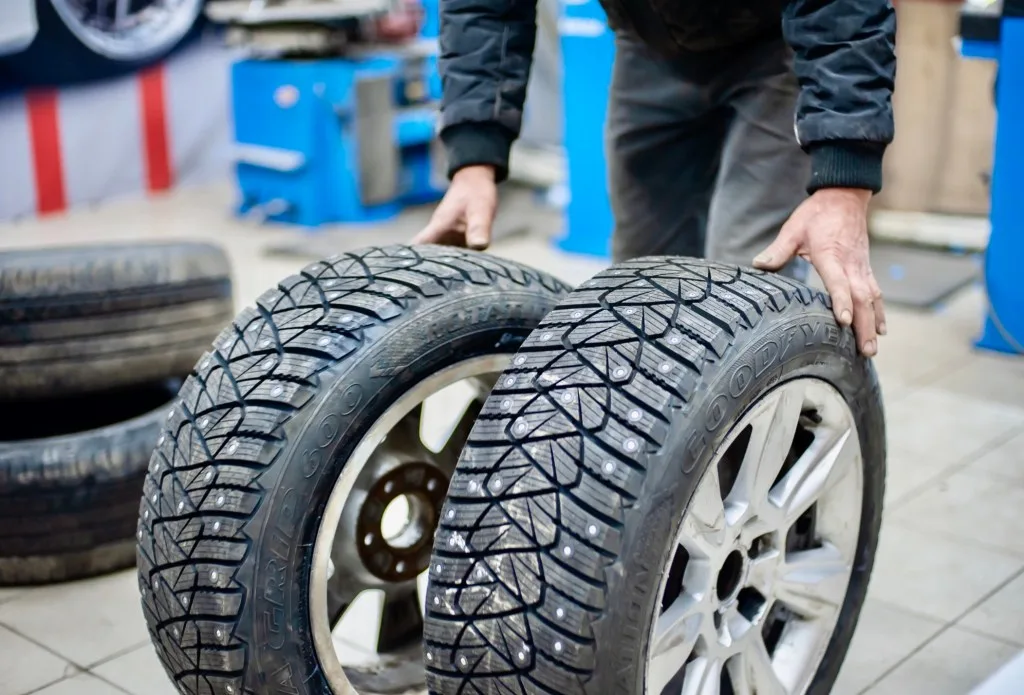You put a lot of trust in your tires to get you safely from point A to point B. However, even if you stay up-to-date on the maintenance of your tires, a sneaky nail can weasel its way into them.
Depending on where it decides to call home in your tire, you may need to replace the tire completely.
But should you replace all your tires at the same time?
Do You Have to Replace All Tires at the Same Time?
For the best handling, comfort, and traction, you’ll want to replace all four tires at the same time. But let’s be real, it seems nails in your tires rarely happen when it’s nearing time to replace your tires. That always seems to happen when there’s plenty of life left in them. So you’re left with choosing between replacing one, two, or all four tires.
The tread depth of your remaining tires will likely determine how many you’ll be purchasing. If the remaining three tires are in great condition and have used no more than half the tread, you can simply buy one tire. However, if you’ve used more than half the tread, you’ll need to replace the two on the same axle.
If you’re driving an all-wheel-drive vehicle, you’ll want to check with your manufacturer. Some vehicle manufacturers recommend replacing all four tires at the same time. If you’re driving a front or rear-wheel-drive vehicle, you only need to replace all four if there is significant wear on all of the tires.

Do You Need an Alignment With 4 New Tires?
Getting an alignment is an excellent idea but not essential. Having your tires aligned ensures they’re traveling down the road at the same angle. This helps ensure there’s an even wear and tear on them and can help you extend the life of your tires.
A front-end alignment typically costs $65 to $100, which is a small price to pay to extend the life of your tires. Some service centers offer lifetime wheel alignment services to have an alignment done every 6,000 miles.
Pro Tip: Keep an eye on your tire pressure to ensure they last longer. Learn more about What Is An RV Tire Pressure Monitor?
When Replacing 2 Tires, Where Should They Go?
If you’re only purchasing two new tires, you should always install them on the rear axle of your vehicle. The partially worn tires should be moved to the front. When driving in dry road conditions, you’ll likely not notice any issues whether they’re put on the front or back.
However, when the raindrops hit the road and make it slick, you’re going to want those new tires on the back. Not having traction on your rear axle can cause you to spin out of control. This can create a hazardous situation, especially if you’re traveling at a high rate of speed.
Can Mismatched Tires Cause Transmission Problems?
Yes, mismatched tires can cause transmission problems. It doesn’t matter whether you’re driving a two-wheel drive, four-wheel drive, or all-wheel drive vehicle.
Mismatched tires can cause a host of issues in the drivetrain, including the transmission.
Tires of different sizes will travel down the road at different speeds. This can cause serious issues in your drivetrain and result in a hefty repair bill. This is often why AWD vehicle manufacturers recommend replacing all four tires. It’s far cheaper to replace the tires than to start replacing expensive drivetrain components.

Do Tires Wear Faster on Front or Back?
If we lived in an ideal world, all four of your tires would wear evenly, and you’d never have tire issues. However, that’s not the case, and tires don’t wear evenly.
The front wheels on a front-wheel drive vehicle will almost always wear down first. This is mainly because the front tires do all the acceleration, turning, and even almost all the braking.
Tires on an AWD will typically wear depending on how you drive on them. If you’re accelerating hard at every traffic light, there’s a good chance the rear tires will wear out much faster than the front tires. However, if you drive more reasonably, all four tires can wear fairly evenly.
Pro Tip: We took a closer look at whether or not you need to rotate RV tires regularly. Check it out!
How Much Should 4 New Tires Cost?
A new set of tires can cost anywhere from $300 to $2,000. The type of vehicle and tire preferences will largely determine the price. A small sedan for commuting to and from work will be much cheaper than tires for a large pickup truck. Some truck tires can cost $300.
When you’re buying a set of tires, you’re not just buying the tires. You’re also likely paying for the professional installation and disposal of the old tires. If you tack on any extended tire warranties, it can get quite expensive in a hurry.
How Often Should Tires Be Replaced?
Tires have an estimated tread life, often between 40,000 miles and 60,000 miles. Unless you live in a very dry desert climate or drive above average mileage, your tires will last approximately four or five years.
You should make sure to rotate them according to the manufacturer’s recommendations if you want to get the longest life out of them.
How many tires have you ever had to replace? Tell us in the comments!
Discover the Best Free Camping Across the USA
To be honest with you, we hate paying for camping. There are so many free campsites in America (with complete privacy).
You should give it a try!
As a matter of fact, these free campsites are yours. Every time you pay federal taxes, you’re contributing to these lands.
Become a FREE CAMPING INSIDER and join the 100,000 campers that love to score the best site!
We’ll send you the 50 Best Free Campsites in the USA (one per state). Access the list by submitting your email below: